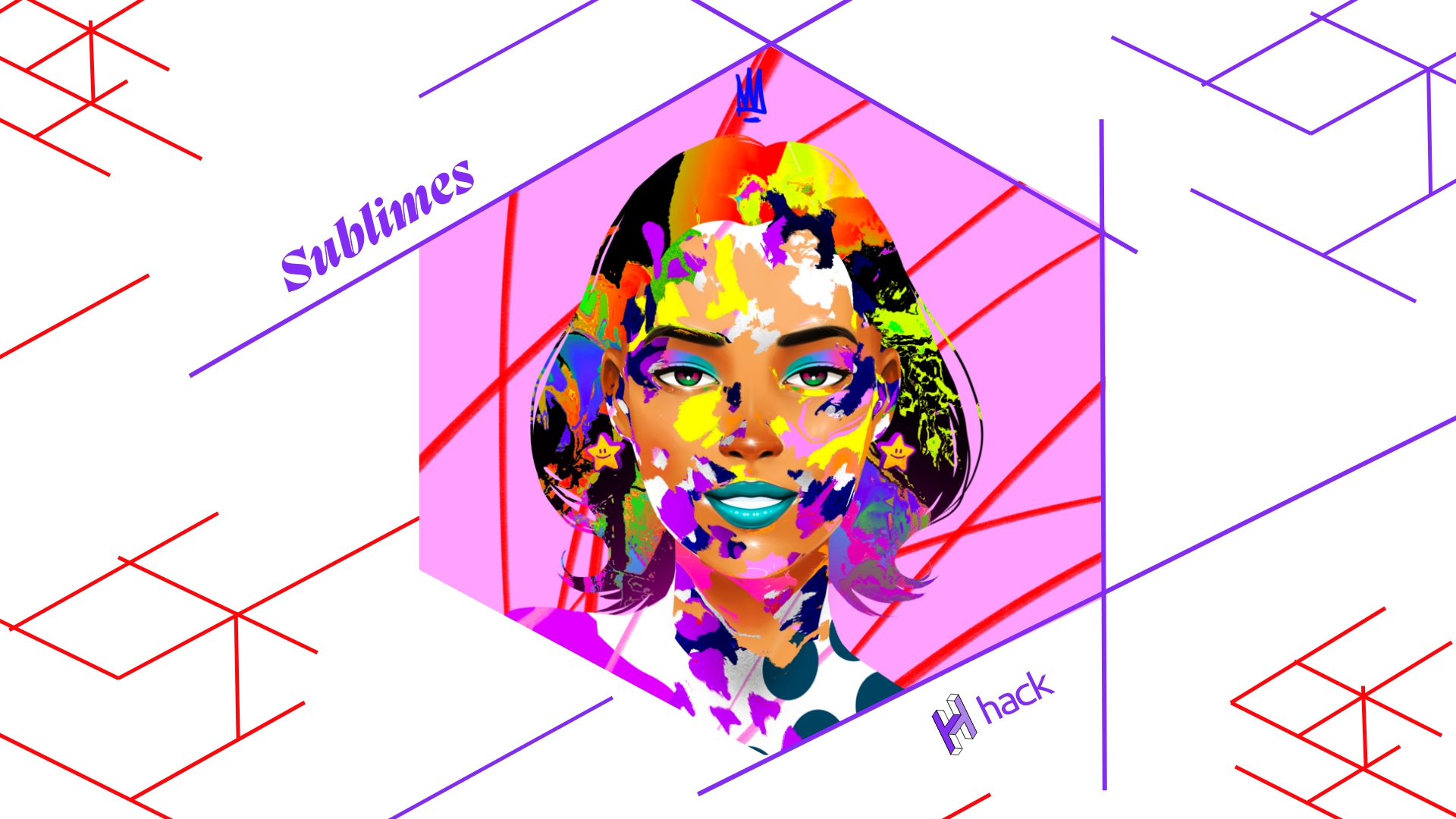About the project:
Sublimes is a generative collection of 1,111 abstract queens who live in different dimensions of the metaverse. The abstract elements in their look come from the fact that we can only perceive some fragments of their dimensions.
It is a collaboration between NFT visionary World’s Greatest NFTs, artist Kaloian Toshev – MZK and hack.bg.
About the developer:
Ivelin is a product-minded Solidity/Web3 engineer with more than 13 years of experience in well known large enterprises and startup companies.
Ivelin is a decentralization and freedom devotee, an ex-entrepreneur listed in Forbes 30-under-30, current blockchain developer at hack.bg and today’s guest on the Let’s talk Blockchain rubric.
Let’s begin!
We all know the NFT ecosystem is bombarded with projects right now and everyone wants to ride on the crest of the wave. So tell me, how do you sift out NFT projects and what do you find unique about the “Sublimes” project?
Like most projects, the driving force is the community behind them. What draws us to certain NFT projects is the connection we feel or want to feel with other like-minded people and the desire to be part of something we believe in.
Certainly, the best way to make us realize we belong to some community is to tell us a story that resonates with our lives and dreams. And art is best at touching us in powerful ways we struggle to explain and yet it just makes sense.
The utility of an NFT project is the next level of leveraging the power of blockchain and enhancing the tools for building sustainable and fair communities. It really has unlimited possibilities and I’m so excited to see what we can make of it.
The Sublimes project has all of the above and I’m lucky to play my role in it. The team is just superb – full of inspiring leaders that I admire. Another great trait of the project is the scarcity — the collection is limited to only 1111 pieces and there will never be more.
And last but not least I find the art very pleasing and eye-catching.
As I know your professional background I have come to the conclusion all of the projects you have been involved in have a cause, some deeper meaning. I believe this is the case here with blockchain as well. Is this what drives you and pushes you to build and what do you think is your impact as a developer in projects like this one?
I recently came to realize the root cause for most issues in modern society is the centralization of power and lack of trust. In the Web 2.0 era, I was trying to build products that incentivize donating to charity causes through mobile technologies and digital marketing. There was a tangible impact on the surface but it was just a painkiller and not a cure. Blockchain technology if used correctly and with good intentions enables new organizational and business models which get deeper and allow for a true change. That’s why I’m fully on board.
My role as a developer is to translate real-world problems into code. Understanding the problem well is key to creating a sustainable and durable solution which is flexible enough to handle the ever-changing world. Conversely, not understanding the problem can lead to a waste of energy for many, not just the developers. I strive to get deep into the domain of anything I build to maximize the results for everybody. After all, technology is just a tool for solving problems.
“Translate real world problems into code” sounds like the perfect definition of a developer to me. Understanding the problem is I guess the first step in the chain of events to create a solution. What are the other steps that follow when planing an NFT project from a developer’s point of view?
The key aspects of a generative art collection are the minting process and the art generation also known in the industry as the drop. The constraints of the drop represent the concept of the project and must ensure its promise to the community. To achieve that trust it’s all encoded into a smart contract which once deployed to the blockchain, cannot be changed.
The minting process includes all stages of the sale and the collection scarcity. Only a predefined number of NFTs can be minted in a set time frame and only by following the rules that guarantee the fairness of the distribution. These limitations are the backbone of an NFT project.
A critical part of the collection distribution is not being able to cherry-pick an art piece – which is a common pitfall for such projects. Additionally, collections without art that “looks rare” will almost certainly be a failure so we had to plan and test carefully the trait distribution correctly. Of course, the distribution is completely random to ensure fairness and unique results.
NFT art collections like Sublimes are expected to be accessible “forever” and stay unchanged so we had to decide how to achieve that. Storing high-quality images on the blockchain is not feasible so we went for a decentralized file storage solution. We chose IPFS to carry out that job and stored only the unique file fingerprints on the blockchain.
Since NFT drops are highly anticipated and happen in a short timeframe the minting web app had to be very robust, secure and ensure high availability across the globe.
Building a project that is expected to stay unchanged sounds like a lot of thinking ahead. Some projects in the ecosystem decide to remain their rights to do some changes on the projects over time. But you are going by the saying “Once on the blockchain, always on the blockchain”. What challenges did you come across during the stages of the development of such project ?
The most challenging parts of building any blockchain-related solution are security and efficiency. All requirements must be implemented in a way that won’t compromise safety or use excessive resources.
Vulnerabilities in the code can cause a disaster and since once deployed the contract cannot be changed it had to be meticulously reviewed and tested. Further, the source code is available for anyone to see for transparency and that gives malicious actors a great advantage and sets the bar very high.
Currently, the Ethereum network is highly congested because of the big competition for a limited amount of storage and transactions throughput. Any inefficient code causes an increase in gas which has to be paid by users of the contract. That can easily price out many users or make the project unsustainable. We had to do lots of optimizations to achieve the leanest implementation without cutting any corners.
Tell me, Ivelin, as a person with experience building blockchain projects, what advice would you give to those with an idea on their mind – whether an NFT, DeFi or other project. What are the things one should know first-hand ?
My advice is to think about the use-case first and then figure out if and how the capabilities of blockchain technology can help. Even prior that a market research should be conducted to see if there’s fit for the product. Existing projects are great for reference and learning from their mistakes. We were able to avoid and plan for many pitfalls thanks to studying other projects’ trajectories and source code.
Unfortunately, lots of the new projects are just copy-cats, at best with some slight parameter tweaking. Obviously, that doesn’t help the space move forward and we need more creativity involved.
From a technical perspective, it’s important the code is future-proof by implementing all standards and by designing with composability in mind. Testing heavily and going through security audits goes without saying, especially if user funds are going to be locked in. We don’t want to lose people’s trust in blockchain technology.
User experience is another aspect that can make or break a project. Even projects with the most secure and well designed smart contract won’t succeed if the target audience doesn’t know how to use it or don’t understand why it exists. Do user testing, make prototypes and ask for feedback as early as possible.
To give this interview some proper ending I would like to know what blockchain means to you, but most importantly – are you hopeful for the decentralized future and are we ready for it?
Blockchain and its promise for decentralization are the natural evolution of things if looked from first principle. Centralized systems are usually just phase one. To me, it’s an inevitable paradigm shift and I’m glad to be part of it. I’ve always wanted to see our society moving towards more transparency, fairness and equality.
It’s honest to say that not everything needs to be decentralized and I’m not a blockchain maximalist. The hype makes a lot of people believe that and it’s sometimes harmful for the perception of the space.
We’re still early in terms of mass adoption but it’s one of the fastest-growing industries given the challenge at hand and the magnitude of disruption. There are a lot of early adopters and believers uniting for the greater good and it’s beautiful to see it happening.



